The Long Game Improvement Plan – Part 4
In this part of the the long game improvement plan we’re going to be looking at the follow-through and the finish of the golf swing. So let’s start by looking at…
The Follow-Through
Now before we begin I want to clear up what the follow-through is and to help me do this I’m going to say what it isn’t!
The follow-through is NOT the end of the swing.
That’s called the finish.
Makes sense, eh?
So the follow-through is everything that happens after impact until you finish the swing.
Just because the ball has already left the clubface it doesn’t mean it’s not important. On the contrary. If you just observed a person’s follow-through you could (in the majority) tell whether that person is a good golfer or not, and here’s an example of this:
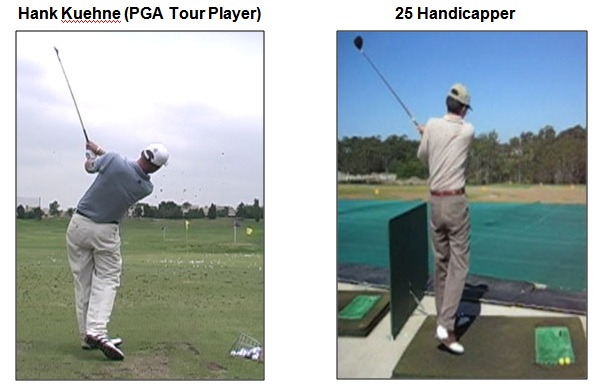
Very rarely do you see someone with a good follow-through who has poor mechanics before that. So does that mean you should try to have a good follow-through?
Not necessarily….but practicing things to improve your follow-through will have a good overall affect on your swing.
Why?
Because to get into good follow-through positions you’ll have to do things prior to the follow-through that will help to improve your swing. Now having said that, unlike everything I’ve discussed previously, the follow-through is one area that I’m more relaxed about what should happen. Because this is one area that allows our differences to shine.
All golfers don’t need to look the same at the end of the swing because all of our swings have different characteristics, i.e. one person will be a power player, another person will have a more conservative, more mechanical swing etc.
The follow-through is where a person is freer to do what comes naturally to them. However, there are certain things that you should be doing in the follow-through and we’re going to start looking at what some of those things are now.
As I said a minute ago, the follow-through includes everything that happens after the ball is hit until the finish of the swing. And there’s something that happens in the follow-through that should happen at no other point prior to that.
What I’m referring to is that both of your arms should be straight just after impact.
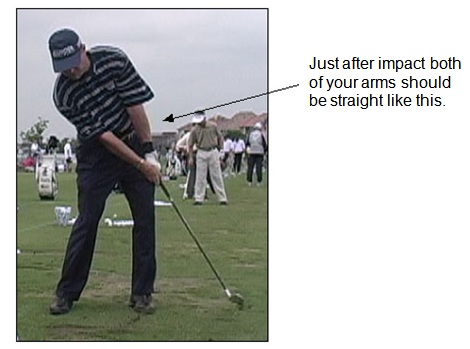
Important Note: At no other point previously in your setup or swing should both of your arms be straight.
Now when the club is in a position where it’s parallel with the ground on the follow-through the clubface should be vertical or straight up and down like this…
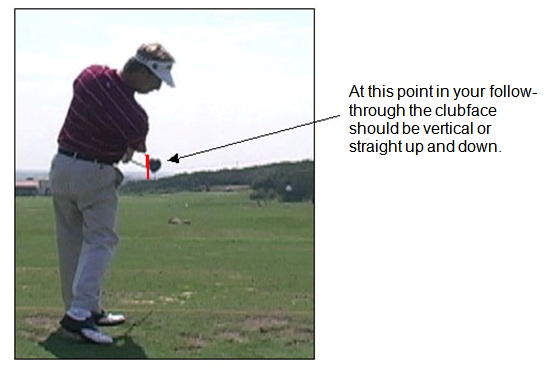
Also, both of your arms should be straight and extended to the target. And your head should be in a similar position to what it was at setup. Your hips should be open and most of your weight should be on your left side.
All right, that’s the some important parts of the follow-through covered. But now I’m going to go into more detail on the release because I know that getting to a position like the one picture above, i.e. the clubface being vertical at this position in the follow-through, can be tough for a lot of golfers. That’s why I give my students the best drills I’ve found to fix this problem.
But most golfers that get in bad follow-through positions do so due to a lack of lower body use, coupled with a lack of right sided power/dominance in the downswing. Now the lack of power/dominance from the right side in many golfers swings is probably a result of golfers so often hearing that we need to quieten down our right side.
However, this is just bad advice and sadly ruins many golfer'[s swings. But the great golfers know this isn’t true and that’s why you get golfers like Ben Hogan saying…
“As far as applying power goes, I wish that I had three right hands!”
Ben Hogan
So let’s clear this up once and for all.
The right side is the power side in the golf swing and you want to apply as much power as you can with this side. The left side is simply there to support and help guide the swing.
Now when I talk about your right side I’m not simply referring to just your right hand. I’m referring to your entire right side, i.e. hand, arm, shoulder etc. And when you follow-through your right side should be much more dominant than your left side. Your left side should be trying to get out of the way of your right side coming through.
Also when you follow-through you want your right side to actually feel like it is going down and around. The only way of doing this naturally is to swivel your head to the left once you’ve made contact with the ball. Look at that Hank Kuehne picture on page 38 to see what I’m talking about.
By swiveling your head at impact and following the flight of the ball it allows you to swing under with your right side — naturally. If you try to keep your head still after impact you’ll find it very hard to get your right side working under and this will cost you a lot of power.
In short, a fixed head will restrict your swing and cost you distance.
OK, that’s the main parts of the follow-through covered. Let’s now look at…
The Finish
The first thing I want to discuss about the finish of your swing is your head. A minute or two ago I said that you should swivel your head on the follow-through so you can follow the flight of the ball, as this helps your right side to move under on the follow-through. Well, during your follow-through not only should you swivel your head but you also must allow it to move towards your target.
Important Note: Don’t try and keep your head stationary during the follow-through because this will create too much stress on your lower back, and that stress will eventually lead to a back injury.
So, by the time you’ve finished your swing your head should be almost a complete head width towards the target.
However, your head should still be behind your lower body, i.e. your hips. Your lower body should always be in front of the upper body from the transition on.
Now because your swing should have such a strong lower body drive towards the target it means that at the end of your swing the sole of your right foot should be almost completely visible when looking at a golfer’s swing from down the line.
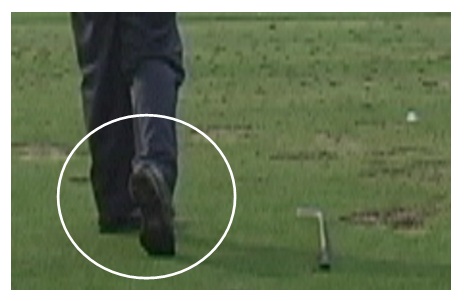
But not only that, your right foot should also be pulled towards the target on the follow-through so that at the finish of your swing the right foot is closer to the target than it was at setup. Also, at the end of your swing your knees should be touching or very close to it. And your left leg should be almost dead straight.
This is a good reference to know that you’ve used your lower body aggressively in the downswing. If your knees are a long way apart at the end of your swing that’s a sure sign that you haven’t used your lower body aggressively enough in the swing.
Now I want to mention your weight distribution — because at the finish of your swing 98% of your weight should be on your left side. And more specifically the weight should be mainly in the heel of your left foot and your left hip.
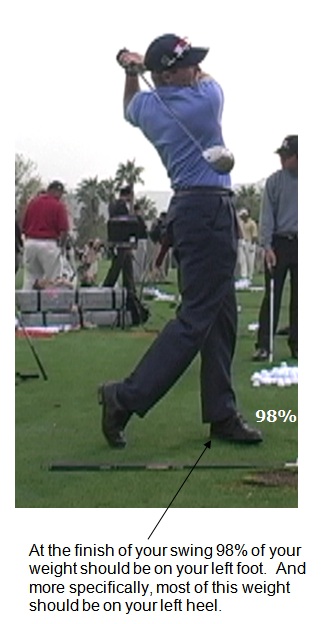
So that’s an overview of what should be happening in your follow-through and at the finish of the swing. This of course should be happening naturally. If it’s not it will be as a result of bad habits previously in the swing
Fix those and then your follow-through and finish will automatically improve.
All right, that’s the end of Part 4 of this Report. Next is Part 5 in which I’m going to discuss tempo, rhythm, timing and an automatic golf swing. Click here to read that.
